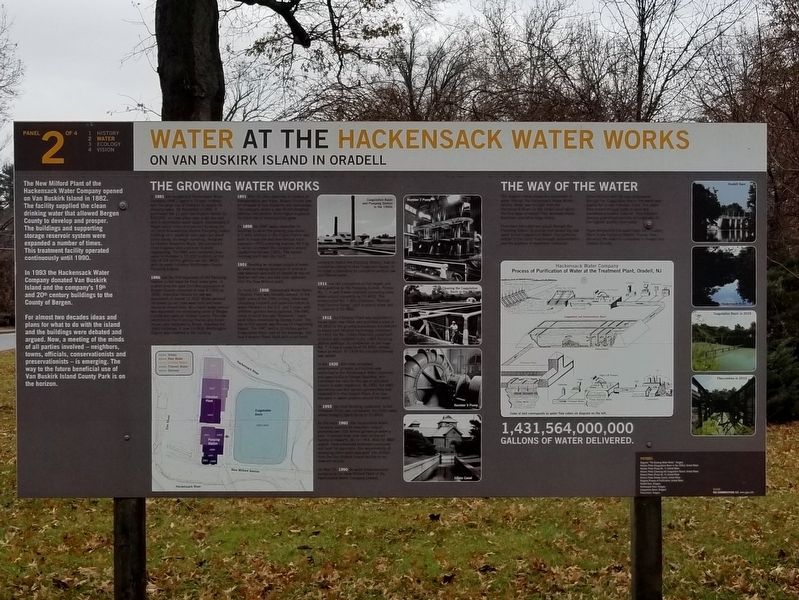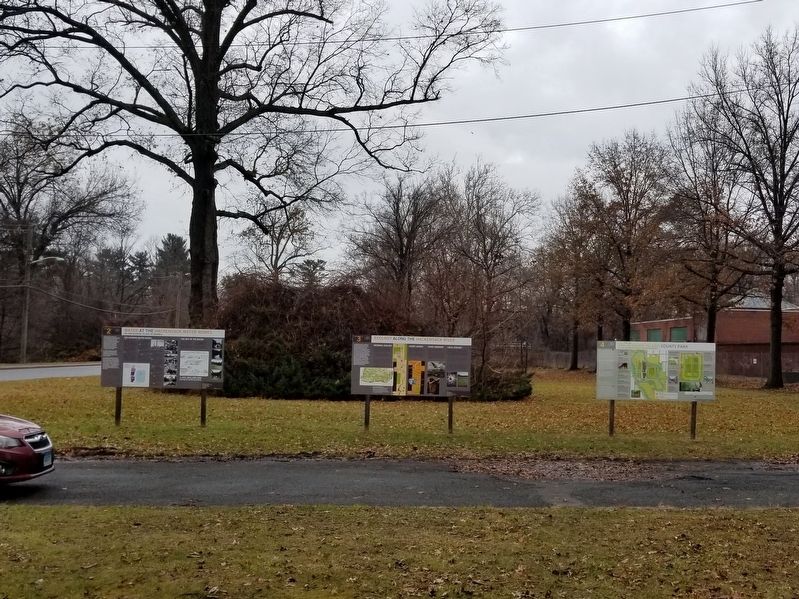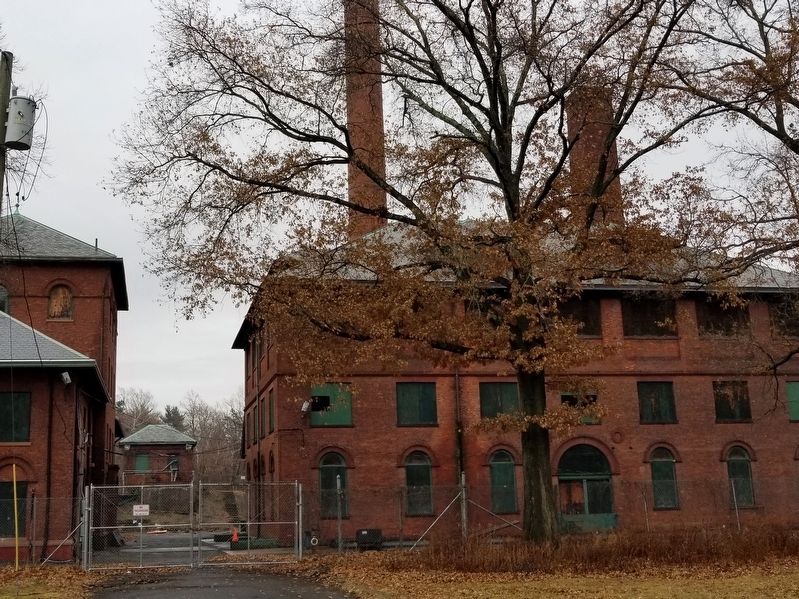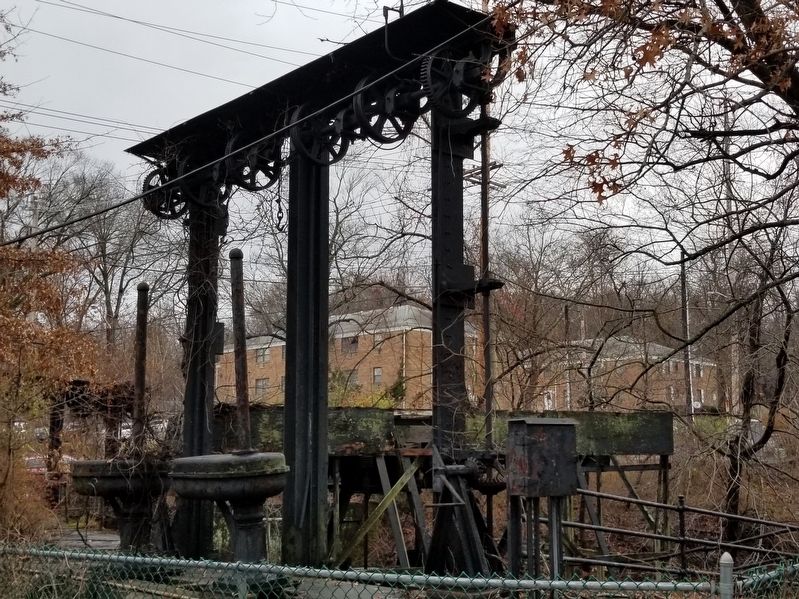Oradell in Bergen County, New Jersey — The American Northeast (Mid-Atlantic)
Water at the Hackensack Water Works
Water at the Hackensack Water Works
on Van Buskirk Island in Oradell
The New Milford Plant of the Hackensack Water Company opened on Van Buskirk Island in 1882. The facility supplied the clean drinking water that allowed Bergen County to develop and prosper. The buildings and supporting storage reservoir system were expanded a number of times. This treatment facility operated continuously until 1990.
In 1993 the Hackensack Water Company donated Van Buskirk Island and the company's 19th and 20th century buildings to the County of Bergen.
For almost two decades ideas and plans for what to do with the island and the buildings were debated and argued. Now, a meeting of the minds of all parties involved — neighbors, towns, officials, conservationists and preservationists — is emerging. The way to the future beneficial use of Van Buskirk Island County Park is on the horizon.
The Growing Water Works
In 1881 the reorganized Hackensack Water Company (HWC) signed a 10-year contract with the large city of Hoboken to supply its drinking water. By November of 1881 it purchased the 11-acre Van Buskirk Island for $50,000, an ideal place near a rail line and with a dependable water supply. Immediately it began laying miles of pipes and building the red brick Romanesque Revival Pumping Station building (still standing) and large coal shed/ boiler house (no longer standing), designed by Charles Benjamin Brush, the company's Chief Engineer and a pioneer in water engineering. The HWC soon delivered clean water to Hoboken's 30,000 residents at the rate of 3.8 million gallons per day (MGD) with its newly installed Worthington Duplex Pumping Engine.
1886 saw the first expansion of the Pumping Station as the need for fresh water grew. In a short time the post Civil War population of Bergen County increased to over 47,000 by 1890, more than double the pre-war population of almost 22,000. Water demand increased as rail lines were built and more residents moved here. As a result water service was expanded into developing areas of Bergen County and parts of Hudson County. The new additions to the Pumping Station and boiler house, also designed by Brush, matched the 1882 buildings. A new 10-MGD Worthington Engine was installed in the building.
1891 With its close proximity to centers of transportation and trade, Bergen County saw an increase of new residents and businesses. The company added a new Brush-designed addition and another Worthington engine as its client list of municipalities grew.
By 1898 the HWC again expanded its facilities to serve the growing population. A 2-story addition to the Pump Station was built to house
the two new vertical triple expansion (VTE) pumping engines, No 5 & 6, which increased the company's output capabilities by over 150%. The square chimney stack was also built.
1901 Needing an increase supply of water to meet increasing expansion of service a new reservoir was built in Oradell at the old Veldran mill site, one-half mile upstream from the New Milford plant.
On June 25, 1906 Hackensack Water Works Filtration Plant was formally opened. In the latter years of the 19th century, there was increasing research and experimentation in water filtration in the U.S. and Europe, with different systems being explored. The HWC chose to build the new "American" rapid sand filters developed by George Fuller. The key to this system was the use of coagulating basins. The HWC built a 12-million-gallon Coagulation Basin east of the buildings. The new Filtration Plant, built with a red brick exterior to match the Pumping Station, had an innovative central 4-story Coagulant House. It included a laboratory to constantly analyze raw and filtered water.
1911 saw the completion of the largest and final addition to the Pumping Station. Pumps No. 7, 8 and 9 were installed increasing daily water output capability by 35 MGD. The monumental No. 7 Allis Chalmers "Vertical High Service Pump" (still in place) alone had a capacity of 20 MGD.
In 1912 the
Filtration Plant was expanded to house eight new filters and provided a total of 48 MGD to the growing population. Innovations to steam and filtration technology continued. In 1915 the No. 3 Allis Chalmers pump (still in place) was installed in the 1886 Pumping Station addition. In comparison to the huge No. 7, it has a capacity of 36 MGD, almost twice as much. In 1918 the circular chimney was added.
In the 1920s the most important development in water purification was attributed to the Hackensack Water Company and specifically to George Spalding, who conceived the idea for the use of activated carbon in water treatment. By 1931 the HWC decided to use this system permanently and installed it in this Oradell Plant. It is now standard in water systems around the world.
In 1955, the final building expansion, to the Filtration Plant, was cormpleted. Six filters were added bringing capacity up to 70 MGD.
By the early 1960s the Hackensack Water Company reached its maximum output pumping over 100 trillion gallons of water a year. it opened their new state-of-the-art facility in Haworth, NJ in 1964. With 50 MGD output, more advanced treatment process and land for expansion, the responsibility of supplying clean water was gradually shifted from the Van Buskirk Island facility to its Haworth facility.
On May 31, 1990 all water treatment and
pumping at the New Milford Plant of the Hackensack Water Company ceased.
The Way of the Water
The diagram below shows the movement of water through the Hackensack Water Works facility. Water was brought from the Hackensack River via the intake canal where the first large screened filter removed leaves, branches, and other large debris.
From here the water was piped through the Pumping Station by pumps that moved the raw water to the Coagulation Basin. Fine particles settled to the basin floor through sedimentation and the addition of treatment chemicals.
Once finished with its slow progression through the Coagulation Basin, the water was gravity-fed to the Filtration Plant. The water then moved through beds of sand and powdered-activated charcoal. This filtration process guaranteed delivery to customers of the highest quality clean water.
Pipes transported the water from the Filtration Plant to the Pumping Station. Pumps then delivered the water to customers in Bergen and Hudson County.
1,431,564,000,000 Gallons of Water Delivered
Pictures
Diagram "The Growing Water Works": Rutgers
Historic Photo (Coagulation Basin in the 1960s): United Water
Historic Photo (Pump No. 7): United Water
Historic Photo (Cleaning the Coagulation Basin): United Water
Historic Photo (Pump No. 3): United Water
Historic Photo (Intake Canal): United Water
Diagram Process of Purification: United Water
Oradell Dam: Rutgers
Hackensack River: Rutgers
Coagulation Basin: Rutgers
Flocculation: Rutgers (Marker Number 2.)
Topics. This historical marker is listed in these topic lists: Industry & Commerce • Notable Places. A significant historical date for this entry is May 31, 1990.
Location. 40° 56.807′ N, 74° 1.56′ W. Marker is in Oradell, New Jersey, in Bergen County. Marker is at the intersection of Elm Street and New Milford Avenue, on the right when traveling north on Elm Street. Located at the Hackensack Water Works. Touch for map. Marker is in this post office area: Oradell NJ 07649, United States of America. Touch for directions.
Other nearby markers. At least 8 other markers are within walking distance of this marker. Ecology Along the Hackensack River (here, next to this marker); Vision for the Van Buskirk Island County Park (a few steps from this marker); History of the Hackensack Water Works (within shouting distance of this marker); Richard T. Cooper House (approx. 0.3 miles away); Hagler’s Diner (approx. 0.4 miles away); New Milford World War I Memorial (approx. 0.6 miles away); New Milford Veterans Memorial (approx. 0.6 miles away); Oradell (approx. 0.6 miles away). Touch for a list and map of all markers in Oradell.
Also see . . . New Milford Plant of the Hackensack Water Company on Wikipedia. (Submitted on February 12, 2019, by Michael Herrick of Southbury, Connecticut.)
Credits. This page was last revised on February 12, 2019. It was originally submitted on February 12, 2019, by Michael Herrick of Southbury, Connecticut. This page has been viewed 314 times since then and 44 times this year. Photos: 1, 2, 3, 4. submitted on February 12, 2019, by Michael Herrick of Southbury, Connecticut.



